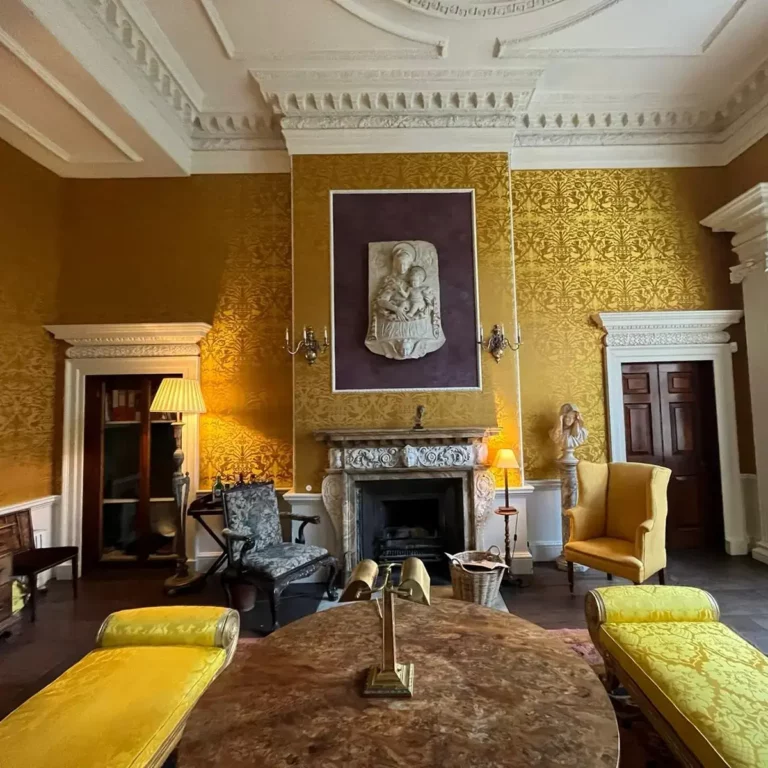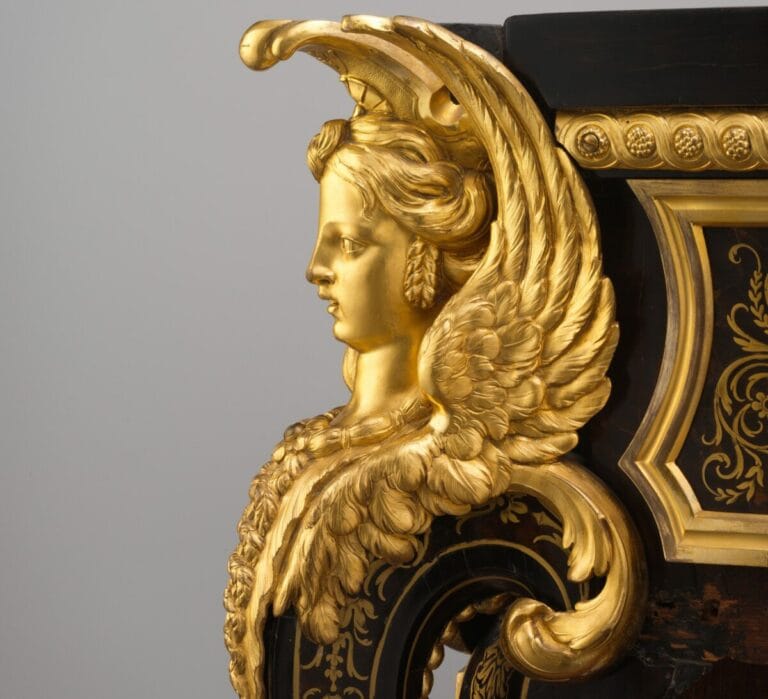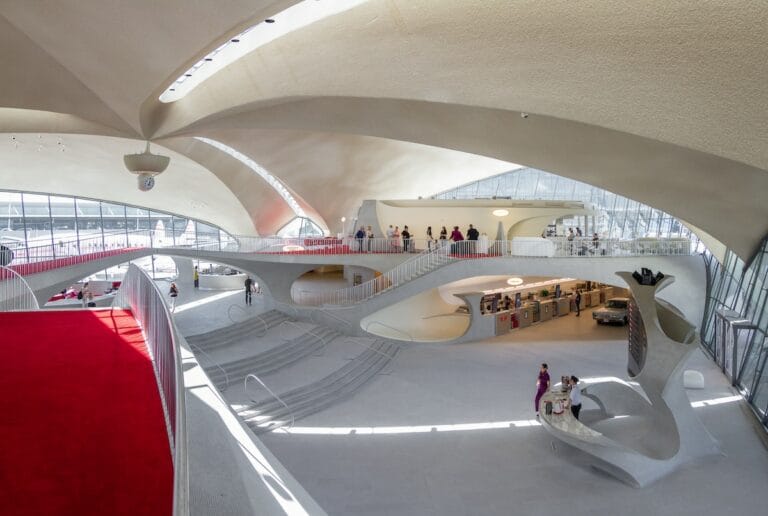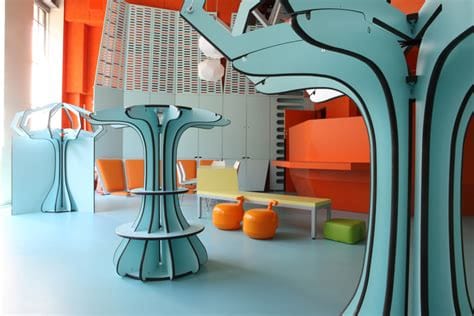Do you know the Consulate style?
Do you know the Consulate style? This crucial artistic period is historically situated between the Directoire and Empire. It marks the consolidation of Bonaparte’s power and the emergence of a renewed French decorative art. It should not be confused with the Directoire style that precedes it nor with the Empire style that follows it.
The Consulate marks a period of creative stabilization. After the revolutionary purification, Bonaparte impulses an artistic renewal that reconciles republican order and rediscovered refinement, preparing the future imperial grandeur.
Consulate: The Art of Stabilization (1799-1804)
This pivotal period, characterized by five years of political consolidation and artistic renaissance, ends with the coronation of Napoleon which would radically transform French aesthetics towards imperial grandeur.
Precise chronology:
• 1799-1804: Political Consulate (5 years)
• 1799-1807: Extended stylistic influence (8 years)
• International equivalents: Early English Regency, Continental Neoclassicism
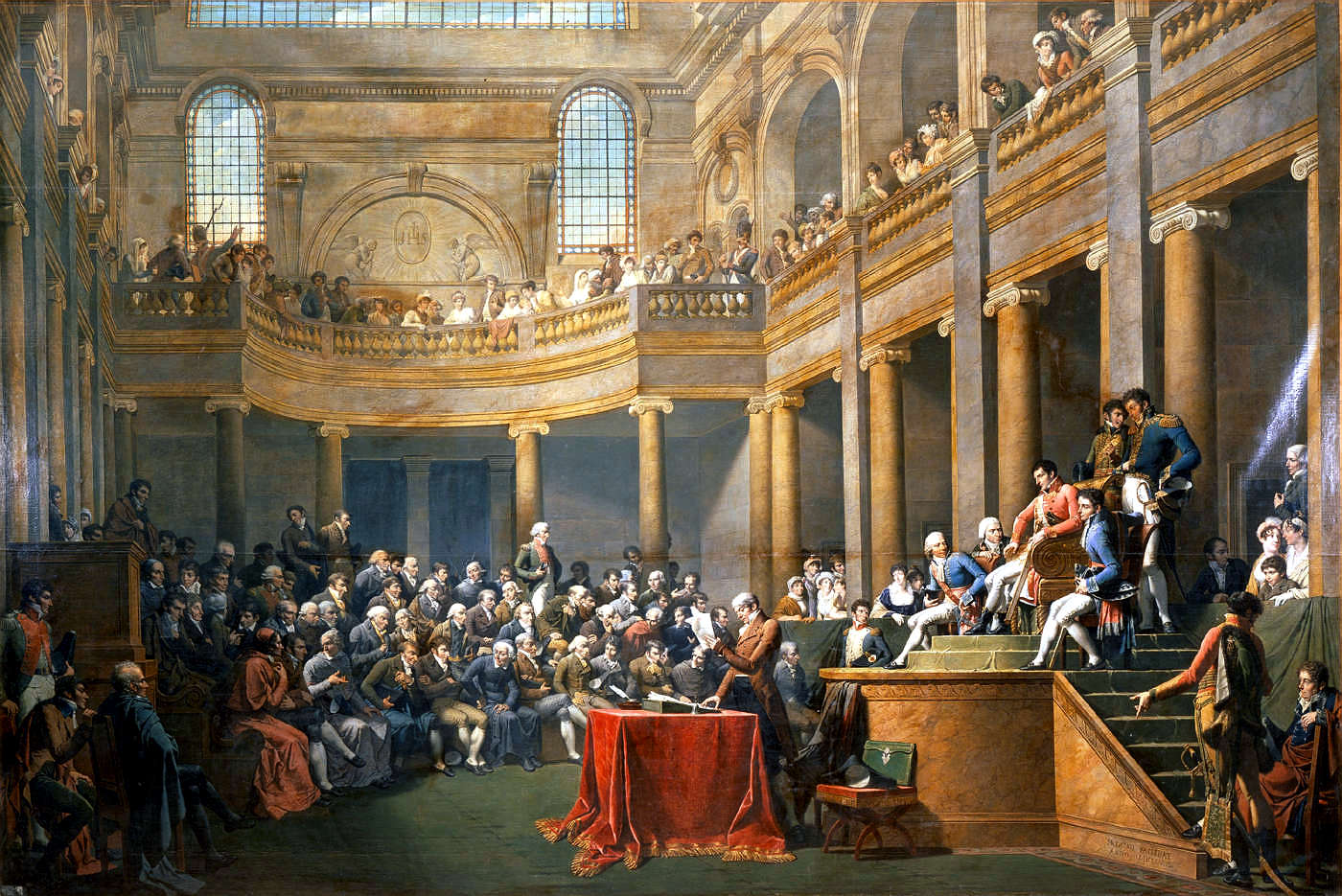
The Consulate is a period in French history, from 1799 to 1804, which bridges the Revolution and the era of Napoleon I.
It is at this time that Napoleon Bonaparte takes power after a period of instability. He becomes the First Consul and, although there were other consuls, it is he who holds most of the authority.
During these years, France stabilizes. It is a period of great reforms: for example, the creation of prefects to manage departments, the Bank of France, and above all, the elaboration of the Civil Code, a fundamental legal text that still organizes our society today.
In summary, the Consulate is the moment when Napoleon profoundly reorganized France and solidified his own power, before becoming emperor.
Consular Society
This era sees the birth of a new French elite that mixes rallied former nobles, enriched bourgeoisie, and executives of the new regime. This unprecedented social synthesis transforms aesthetic codes and creates an original artistic demand.
Joséphine de Beauharnais, Madame Récamier, Madame Tallien embody this feminine modernity that profoundly influences the evolution of French taste.
A recovered prosperity after the revolutionary troubles allows the renaissance of decorative arts and the emergence of a democratized luxury market.
This social stabilization generates a balanced aesthetic that reconciles republican ideals and search for beauty, prefiguring modern art de vivre.
Revolution of Taste and Customs
The Consulate sees the assertion of a new relationship with decorative art that favors quality over ostentation and functionality over pure representation.
This era marks the emergence of bourgeois art de vivre that reconciles elegant simplicity and technical refinement.
Consular aesthetics favors proportional harmony and classical measure: refined forms, noble materials, chosen ornaments testify to a search for revolutionary balance.
Arts: Peaceful Neoclassicism
David and the School of Measure
Consular art favors a peaceful neoclassicism that abandons revolutionary coldness to rediscover grace and sensitivity. Jacques-Louis David evolves towards more softness and humanity in his compositions.
Pierre-Paul Prud’hon (master of feminine grace), François Gérard (portraitist of the consular elite), Anne-Louis Girodet (poet of painting) embody this aesthetic transition.
Jean-Antoine Houdon perfects the art of sculpted portraiture, while Antonio Canova seduces the French elite with his neoclassical genius.
Artisanal Renaissance
The Consulate sees all French art crafts spectacularly reborn after the revolutionary parenthesis, stimulated by the demand of a stabilized society.
Pierre-Philippe Thomire (master bronze worker), the Jacob brothers (innovative cabinetmakers), Martin-Guillaume Biennais (goldsmith of the First Consul) redefine French excellence.
French watchmaking triumphs with Abraham-Louis Breguet who revolutionizes the art of measuring time and seduces all of Europe.
Sèvres porcelain regains its reputation under the direction of Alexandre Brongniart, while Parisian goldsmithing reconquers its European supremacy.
Henri Auguste and Jean-Baptiste-Claude Odiot develop techniques that will triumph under the Empire, creating a goldsmithing art of remarkable geometric purity.
Consular Architecture: Elegance and Sobriety
Percier and Fontaine: The Style Creators
The Founders: Charles Percier and Pierre Fontaine develop under the Consulate their revolutionary aesthetic that reconciles ancient grandeur and modern comfort.
Their first achievements (Malmaison, Parisian private mansions) reveal a decorative genius that durably influences Western art.

The creation of refined living spaces (libraries, music salons, boudoirs) responds to the aspirations of a society rediscovering private art de vivre.
The invention of modern decorative comfort transforms French housing and influences European domestic architecture for the entire 19th century.
The French Neoclassical School
Consular architecture is characterized by noble bareness and mastered geometry that establish the canons of modern French architecture.
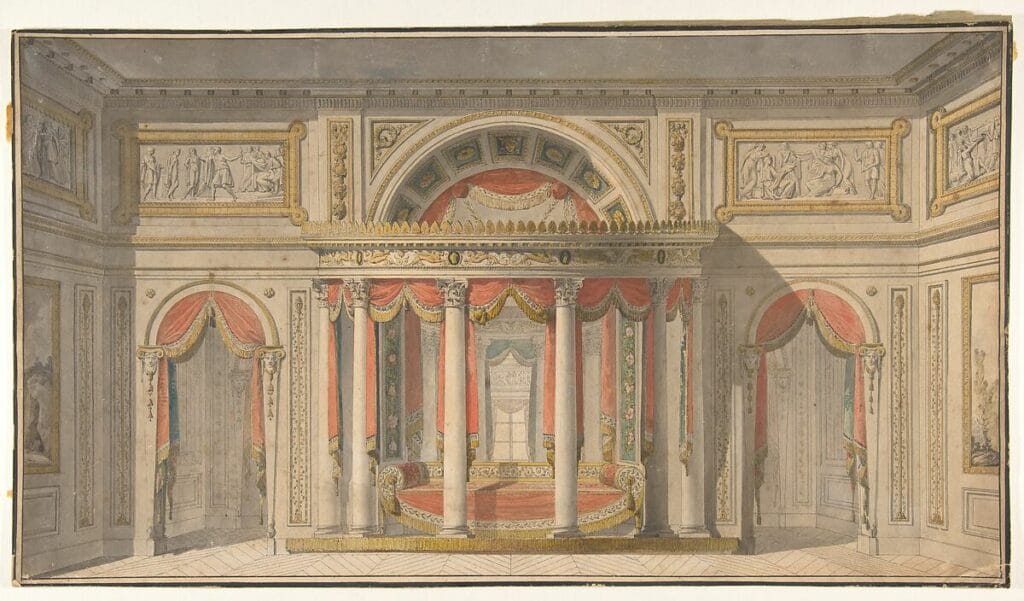
Jean-Nicolas-Louis Durand (architecture theorist), Antoine-Laurent-Thomas Vaudoyer (refined creator) complete this French school that radiates in Europe.
This architectural aesthetic, admired by contemporaries, establishes the bases of modern French public and private architecture.
It revolutionizes our conception of inhabited space and durably imposes the French reference in architectural art.
Integrated Decorative Art
The Consulate perfects the global approach to decoration where each element contributes to an overall harmony of modernized ancient inspiration.
Creators develop an art of decorative ensemble that will durably influence Western furnishing.
Decorative Innovation
The Consulate codifies an ornamental repertoire of revolutionary sobriety: stylized palmettes, geometric rosettes, ancient friezes replace the disappeared rococo ornamentation.
Jean-Guillaume Moitte (sculptor-ornamentalist), Jean-Simon Devauge (draftsman) enrich this vocabulary through their aesthetic research.
The influence of archaeological discoveries and nascent Egyptomania discreetly introduces a learned exoticism that renews French decorative inspiration.
Artisanal techniques are perfected with the renaissance of chiseled bronzes, prestige cabinetmaking, geometric goldsmithing.
Textile art is reborn with Lyon silks and the first creations of reorganized national manufactures.
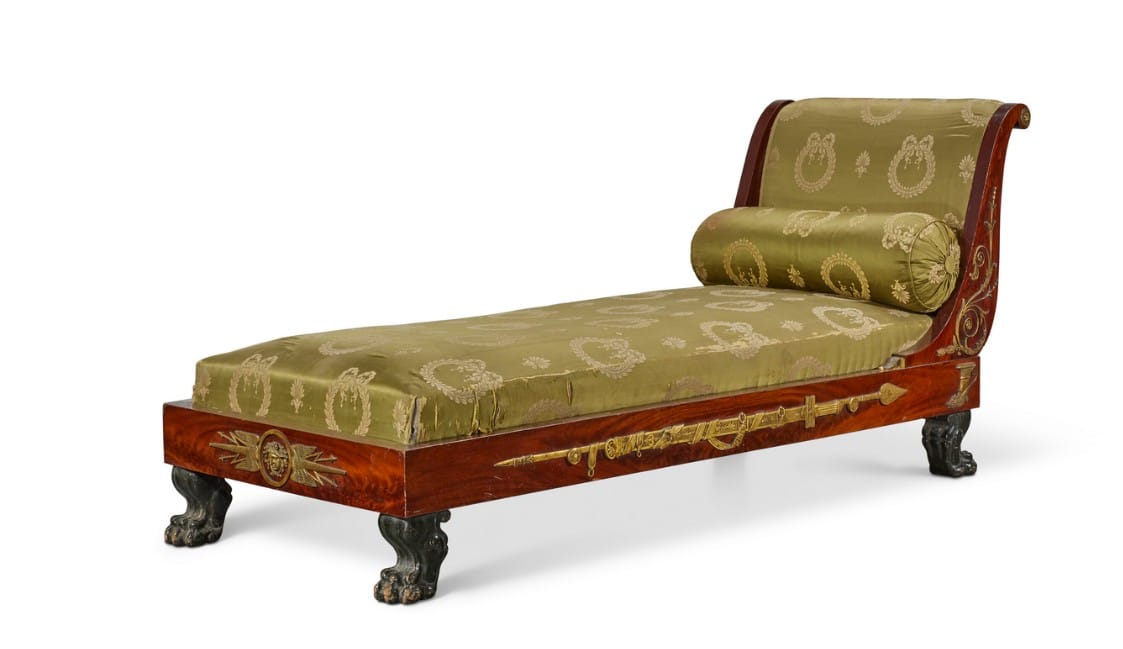
The creations of Biennais (goldsmithing), Thomire (bronzes), Jacob (cabinetmaking) establish new standards of French quality that radiate in Europe.
The goldsmithing of Biennais, the bronzes of Thomire, the furniture of the Jacobs interpret ancient aesthetics according to the French taste for measure and elegance.
Noble simplicity, technical perfection, proportional harmony characterize this aesthetic of stabilization that prepares imperial grandeur.
The library of Joséphine at Malmaison, decorated by Percier and Fontaine, offers the perfect example of this consular elegance where refinement and functionality balance harmoniously.
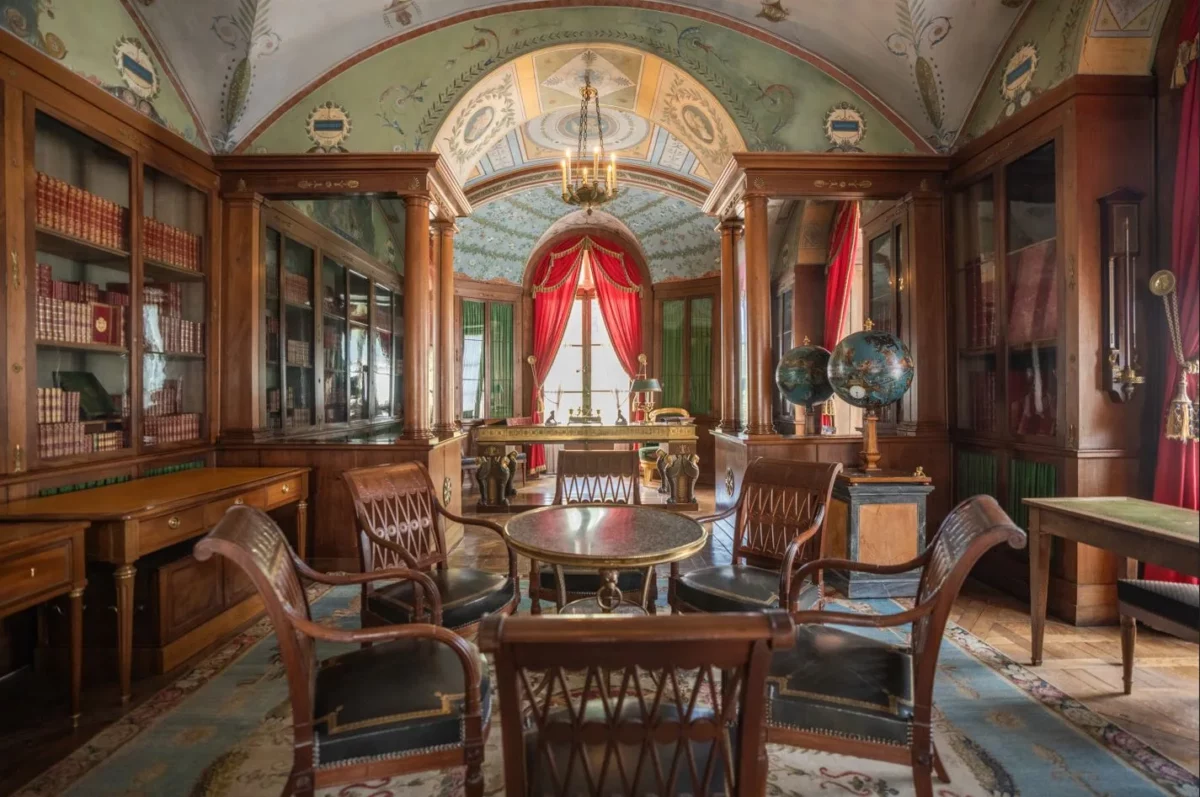
Consulate Furniture: Perfection and Balance
Revolution of form: Consulate furniture perfects decorative refinement by favoring purity of lines and excellence of proportions over ornamental richness.
This revolutionary approach creates an aesthetic of striking modernity that durably influences Western furniture art.
Cabinetmakers favor solid mahogany for its natural nobility, often enhanced with gilded bronzes of perfect geometric sobriety.
The art of ornamentation is refined and stylized: ebony fillets, geometric marquetry, chiseled bronzes create decorative effects of unequaled distinction.
Creators innovate with the measured use of contrasting materials: dark and light woods, bronze and lacquer, creating a decorative palette of new sophistication.
Technical perfection: Consulate furniture favors pure geometric forms and artisanal excellence in creations of perfect balance.

This formal perfection revolutionizes French aesthetics and announces future imperial excellence.
The era draws from Greco-Roman Antiquity with new erudition: architectural forms, geometric motifs, mythological references testify to this learned inspiration.
Discreet Egyptomania, preparing the Egyptian Expedition, subtly introduces sphinxes, palmettes and pharaonic motifs into the decorative repertoire.
The ingenuity of cabinetmakers creates a functional typology adapted to the new needs of consular society: comfort, intimacy, measured representation.
Consulate interiors are characterized by their noble bareness and refined functionality, prefiguring modern art de vivre.
The mastered geometry and use of chosen materials create an aesthetic of democratic excellence accessible to the new French elite.
Consulate Furniture: Types and Innovations
Seating: Towards Formal Perfection
Consulate seating achieves perfect balance between modern comfort and ancient aesthetics in creations of revolutionary formal purity.
The refinement of neoclassical lines reaches its apogee with forms of perfect geometry that durably influence Western design.
Ornamentation is refined: gilded bronzes of exceptional fineness, precise caning, chosen fabrics create an unequaled decorative harmony.
Gondola chairs reach their formal perfection with curves of mathematical elegance that seduce all of Europe.
The straight-back armchair becomes emblematic of the era, combining ancient reference and modern comfort in a delicate balance.
Bergères retain their generous volume but adopt refined lines that favor decorative essentials.
Curule stools reach a technical perfection that makes them true functional sculptures.
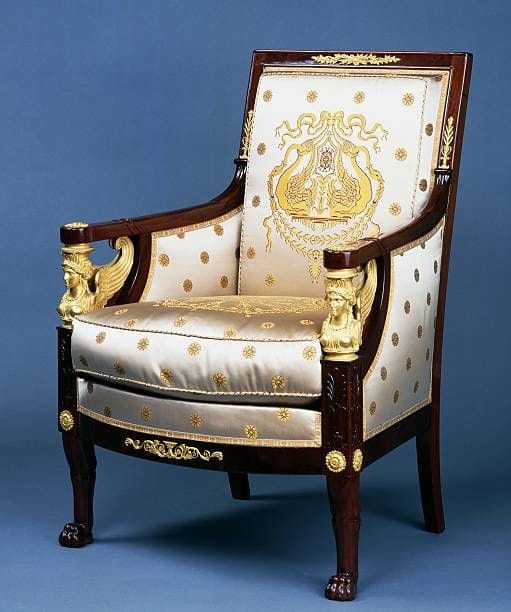
Tables: Geometry and Nobility
Formal innovation: The Consulate table favors architectural forms and nobility of materials in creations of sophisticated simplicity.
This innovative approach durably influences the art of table-making and establishes the bases of modern design.
Salon tables adopt circular or polygonal forms of perfect geometry, often decorated with chiseled bronzes.
Work tables develop a new ergonomics that reconciles beauty and functionality in daily use.
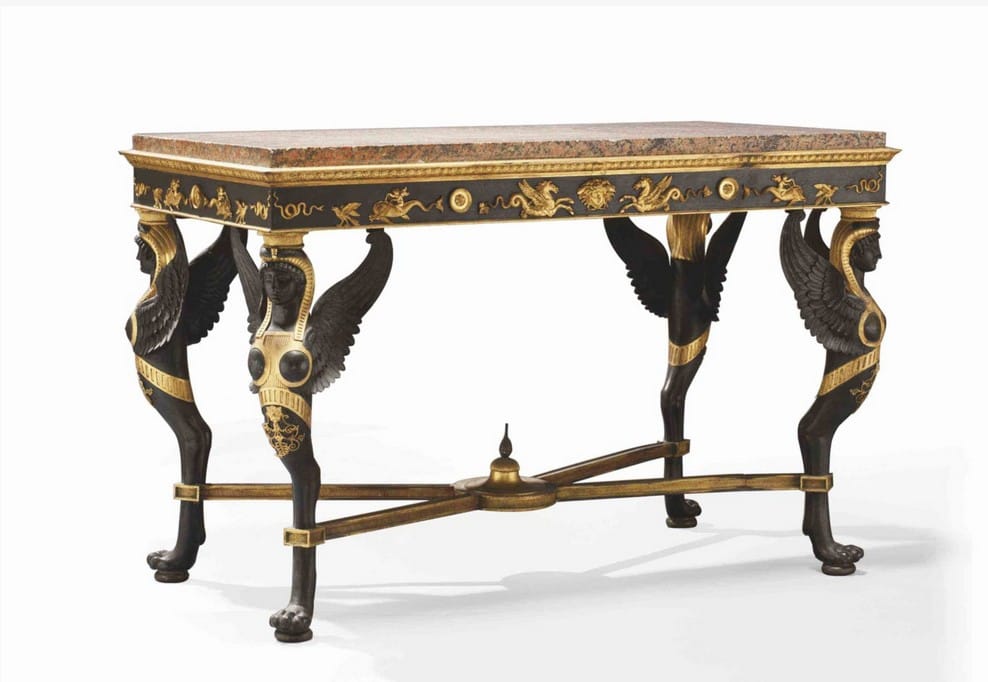
Commodes and Storage: Functional Purity
Consulate storage furniture achieves a formal purity that revolutionizes the aesthetics of utilitarian furniture.
Beds: Simplicity and Comfort
The Consulate bed perfects the “boat” form inherited from the Directoire by bringing it a decorative nobility that seduces the European elite.
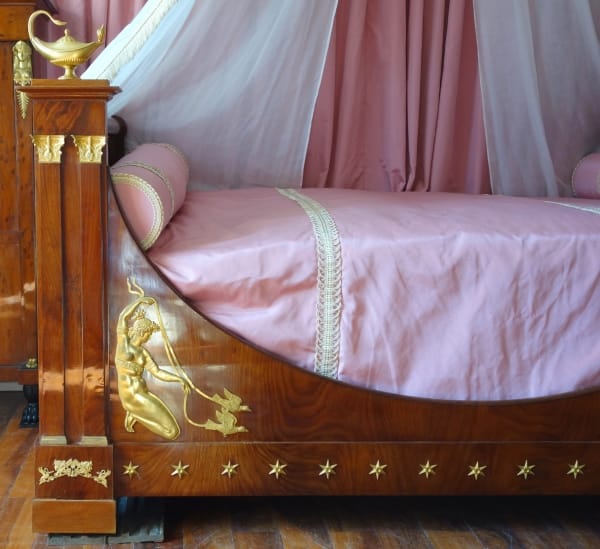
Art Objects: Technical Excellence
The Consulate era sees the birth of an art of decorative object of technical quality that influences European craftsmanship for the entire 19th century.
Breguet clocks revolutionize world watchmaking, while Thomire bronzes establish new aesthetic standards.
The Masters of Consulate Style
The Consulate reveals an exceptional generation of craftsmen who perfect French decorative art and prepare future imperial excellence.
The Jacob Brothers: Geniuses of Cabinetmaking
Georges Jacob and his sons achieve under the Consulate a technical mastery that durably influences world cabinetmaking.
Their revolutionary approach reconciles French tradition and formal innovation in creations of unequaled perfection.
Jacob techniques (perfected assemblies, mathematical proportions, impeccable finishes) establish the standards of French excellence.
Their creations for Joséphine and the consular elite testify to their ability to translate the aesthetic aspirations of their era.
Thomire: The Art of Sublimated Bronze
Pierre-Philippe Thomire develops under the Consulate the innovations that revolutionize the art of decorative bronze.
His creations (clocks, lighting, furniture fittings) reveal exceptional technical mastery and artistic sensitivity.
The Thomire workshop trains the generation that will dominate European bronze art throughout the 19th century.
Biennais: Modern Goldsmithing
Martin-Guillaume Biennais revolutionizes goldsmithing by developing a geometric style that announces imperial aesthetics.
His creations for Bonaparte and the consular elite establish new aesthetic canons that influence European goldsmithing.
His perfect technical mastery and sense of formal innovation make him the precursor of modern goldsmithing.
The Consulate: Laboratory of Decorative Modernity
Consulate style constitutes a unique creative moment in the history of French decorative art, synthesizing revolutionary achievements and preparing imperial excellence.
Its essential lesson – reconciling order and freedom, tradition and innovation, simplicity and refinement – resonates with striking relevance in our era seeking balance.
This period teaches us that the most beautiful creations are born from creative stabilization that allows talents to flourish in a peaceful political and social framework.
Modernity of Consulate Style
Consular aesthetics remarkably anticipates several concerns of contemporary design:
• Functional refinement that favors the essential over the decorative
• Artisanal excellence that values know-how over mass production
• Mastered geometry that creates beauty through proportion rather than ornament
• Noble materials that favor durability over immediate effect
Discreet Contemporary Influence
Consulate style discreetly but profoundly influences the most refined contemporary creation:
Furniture designers: Consular refinement inspires contemporary creators seeking pure and timeless forms.
Interior architects: The art of proportional harmony developed under the Consulate guides the most successful contemporary layouts.
Luxury houses: Consular technical excellence inspires contemporary research of artisanal quality and creative durability.
Market and Recognition
The art market is progressively rediscovering the exceptional quality of Consulate furniture:
Critical revaluation: Experts recognize the decisive contribution of the Consulate to the evolution of Western decorative art.
Informed collectors: A clientele of connoisseurs appreciates the technical perfection and sophisticated refinement of these creations.
Progressive valorization: Authentic pieces reach prices that reflect their rarity and historical importance.
Consulate: Creative Refinement
Consulate style demonstrates that it is possible to create a revolutionary aesthetic by favoring perfection over profusion, quality over quantity.
This lesson particularly resonates in our contemporary era where the search for the essential and authentic guides the most talented creators.
The Consulate teaches us that true modernity is born from the ability to refine without impoverishing, to simplify without banalizing.
Specialized Restoration Techniques
The restoration of Consulate furniture requires particular expertise, adapted to the technical specificities of this period:
Mahogany and finishes: Consulate furniture, often in solid mahogany, requires restoration techniques that respect period varnishes and natural patinas.
Gilded bronzes: Consular gilding, of particular fineness, demands nuanced restoration that preserves their characteristic matte shine.
Jacob assemblies: The technical innovations of this dynasty require in-depth understanding for authentic restoration.
Precise caning: Consular seats, often caned with geometric precision, require exceptional traditional know-how.
The Excellence of Measure
Consulate style demonstrates that French excellence resides in the ability to create beauty through correctness of proportions rather than decorative accumulation.
This lesson of measure and balance particularly resonates in our era where the search for the essential guides the most visionary creators.
Contemporary creators who draw inspiration from this heritage perpetuate a French tradition of excellence that favors quality over quantity, durability over effect.
Differentiating Directoire and Consulate
The Directoire style (1795–1799) and the Consulate style (1799–1804) appear at the junction of the French Revolution and the Empire. Although they share a neoclassical base, their differences are clear: the first expresses republican sobriety and the spirit of renewal, while the second already announces imperial grandeur with more massive lines and more assertive iconography. This comparative table presents the essential points to clearly distinguish these two styles.
| Characteristic | Directoire Style (1795 – 1799) | Consulate Style (1799 – 1804) |
|---|---|---|
| Historical context | After the Revolution, under the Directoire regime. Period of reconstruction and republican austerity. | Under Napoleon Bonaparte’s Consulate, before the Empire. Consolidation of power and staging of authority. |
| Main inspiration | Greek and Roman Antiquity, with revolutionary influence (civic symbols, freedom). | Roman and Egyptian Antiquity, highlighting imperial and military symbols. |
| Forms | Straight lines, sober profile, light proportions, slender furniture. | Straight but more massive lines, fuller proportions, monumental aspect. |
| Ornamentation | Very discreet: fillets, simple moldings, light engraved or painted motifs. | Richer: gilded bronzes (sphinxes, eagles, palmettes, crowns), applied sculptures but still with sobriety. |
| Materials | Light woods or mahogany, sometimes painted, simple marquetry, little bronze. | Solid mahogany, noble veneers, regular use of gilded bronze and more precious inlays. |
| Symbols | Phrygian cap, fasces, hand of justice, scales, Greek columns. | Sphinx, imperial eagle, laurel, weapons, military trophies, Egyptian motifs. |
| Typical seating | Armchairs with crosse or Etruscan back, simple chairs, tapered legs. | Gondola armchairs, straight or slightly curved backs, saber legs, sculpted armrests (swans, claws). |
| General atmosphere | Lightness, republican sobriety, “civilized” and democratic furniture. | Gravity, prestige, affirmation of power, preparation for imperial grandeur. |
If it is more massive, in dark mahogany, with gilded bronze and imperial iconography → Consulate.
Differentiating Consulate and Empire
The Consulate style (1799–1804) and the Empire style (1804–1815) embody two successive faces of official taste under Napoleon Bonaparte.
Both share neoclassical bases and a fascination for Antiquity, but are clearly distinguished in their intention and expression.
The Consulate, still marked by the sobriety inherited from the Revolution, imposes a measured monumentality and discreet symbols of power.
The Empire, on the other hand, openly affirms imperial grandeur through more massive furniture, spectacular ornamentation and triumphant iconography.
This comparative table highlights the visual and decorative keys to differentiate these two styles.
| Characteristic | Consulate Style (1799 – 1804) | Empire Style (1804 – 1815) |
|---|---|---|
| Historical context | Period of Napoleon Bonaparte’s First Consulate. Transition between post-revolutionary sobriety and imperial pomp. | Napoleon as emperor, affirmation of absolute power and grandiloquent staging of the Empire. |
| Forms and proportions | Straight lines, balance and mastered monumentality. Massive but still sober furniture. | Even more massive straight lines, amplified proportions, sensation of power and grandeur. |
| Ornamentation | Rich but contained decor: palmettes, laurel wreaths, sphinxes, discreet eagles, military trophies. | Abundant and spectacular decor: eagles in large format, imperial bees, crowned N, winged Victories, more theatrical mythological motifs. |
| Ancient inspiration | Roman and Egyptian Antiquity: direct influence of the Egyptian campaign, warrior and architectural symbols. | Glorified Roman and Greek Antiquity, quasi-imperial staging, ostentatious mythological references. |
| Materials | Solid or veneered mahogany, gilded bronzes chiseled with fineness, often sober marble (gray, blue turquin, white veined). | Solid or veneered mahogany, more voluminous and imposing gilded bronzes, more varied colored marbles (green, red, black). |
| Symbols | Eagle, sphinx, laurel, palmettes, Egyptian heads, columns, fasces. | Imperial eagle in dominant position, bees, crowned N, Victories, imperial crowns, chariots, figures of gods. |
| Typical seating | Gondola armchairs, straight or crosse backs, saber legs, sculpted armrests (swans, claws, sphinxes). | More massive armchairs and chairs, solid or rectangular backs, more imposing sculpted decors (trophies, eagles, lion heads). |
| General atmosphere | Noble sobriety, rigor, affirmation of power but with restraint. | Grandiloquence and imperial splendor, furniture conceived as propaganda instrument. |
The Empire is monumental and demonstrative, with large format imperial symbols and overloaded decor.

Digital entrepreneur and craft artisan, I use my unconventional background to share my vision of luxury design and interior decoration — one enriched by craftsmanship, history, and contemporary creation. Since 2012, I have been working daily in my workshop on the shores of Lake Annecy, creating bespoke interiors for discerning decorators and private clients.

